An Oasis of Tranquility in HK
Set your web browser to Google Images and look up Nan Lian Garden in Hong Kong and you’d be forgiven for thinking there is little else to see here apart from a gaudy, over-gilded pagoda linked by a couple of red bridges to the main path around the park. It’s the one thing that everyone wants to photograph, the one thing that everyone wants to have a selfie taken against and the one thing that smacks you in the eye the moment you walk through the entrance.
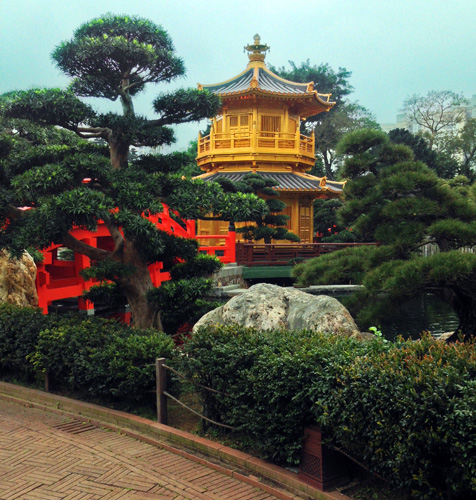
This is the second time I have visited this garden, and for me the pagoda is one of the lesser attractions of Nan Lian. Maybe I’m a heretic as far as tourism is concerned, but there is so much more to enjoy in this stunning park that I sometimes wonder how much some people must miss when their eye is caught by the in-your-face objects which can eclipse the more subtle – and, for me, much more attractive aspects.
The Nan Lian Garden (南蓮園池) is a Chinese Classical Garden situated in Diamond Hill, about 25 minutes by MTR from Tsim Sha Tsui. Some 3.5 hectares in size, it was a joint project of Chi Lin Nunnery and the Hong Kong Government that was opened to the general public on November 14, 2006 – or November 15th, depending on which web site you look at!
It’s a Tang-style (618 - 907 AD) landscaped Chinese garden of classical elegance based on the blueprint of the famous Jiangshouju Garden in Shanxi Province – the only Tang landscape garden the original layout of which can still be traced today. Hills and rocks, water, plants and timber structures are built and arranged according to classical Tang rules, but built in modern times, with its architecture and landscaping reflecting the natural environment in a manner conducive to a sense of serenity and tranquillity, right in the midst of the urban city hustle.
The garden was jointly developed by the Leisure and Cultural Services Department of the Hong Kong SAR Government and the Chi Lin Nunnery. HK funded the infrastructure while Chi Lin manages it for a nominal fee of HK$1. I’ll bet that has to be the best value for money deal that HK has ever negotiated!
The Chinese tradition of 'earth enclosing rocks' is adopted for the formation of hillocks in the garden. The preponderance of rocks comes from Sanjiang County in the Guangxi Zhuang Autonomous Region. Distinctive timber structures include pavilions, terraces, a waterside pavilion, bridges and a Black Lintel. Some of the old trees in the garden include Buddhist Pine, Japanese Black Pine, Cypress, and Myrtle. The garden has been designed with the idea that visitors follow a one-way route, both to cut down on congestion, and to appreciate it at its finest.
The main gate was carefully positioned to form a divide between the Garden and the city streets, keeping out the city sights and sounds while, perhaps more importantly, diverting the sightline away from two flyovers and lessening the sense of oppression they created. The entrance to the Garden is craftily located just below a gap between the flyovers, so that light shines down and one can see the sky. Once through the gate, however, the space opens wide, and the contrast with the outside world is very marked. Noise barriers shield the gardens from the sound of traffic outside the garden and mounds have been placed around the whole garden with extensive planting of trees to filter exhaust and dust from the surrounding area. It all looks so easy, but it must have taken a great deal of planning!
The first structure one passes is a permanent exhibition gallery of Chinese Timber Architecture that houses the scaled models of historical timber structures listed as National Key Protected Heritage in China; but I’m afraid I have been spoiled, having lived in Beijing for the past three years. Their ancient architecture museum beats this one hands down.
Strangely enough, the one-way route is exactly at odds with the printed off guides, on which the numbered route takes one anticlockwise round the park as opposed to the clockwise direction that one is encouraged to go in on entering. I suspect the original plan was that you would end up leaving the park by going in to the Nunnery – of which more later – but this route all but forces you to visit the architectural gallery first, rather than after you have seen the rest of the park – which is a pity I think.
Shortly after the gallery is a monument standing at the bottom of a set of stone stairs going up to the Nunnery. It’s called ‘The Lamp of Enlightenment’. And I can’t make up my mind if it’s nice or just plain ugly.
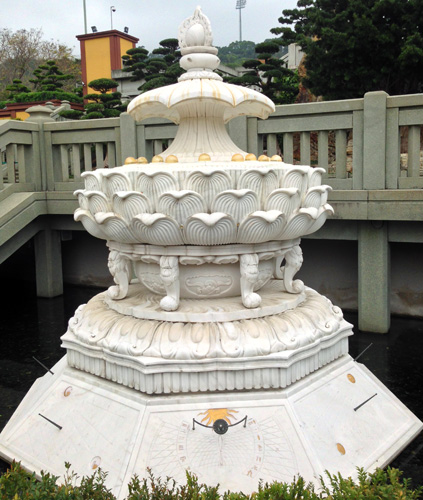
But just take a look at its base. There’s an amazing sundial there which most people walk straight past without a second glance. I’ve searched the web, looking for information about it, but to no avail. Perhaps someone can tell me about it?
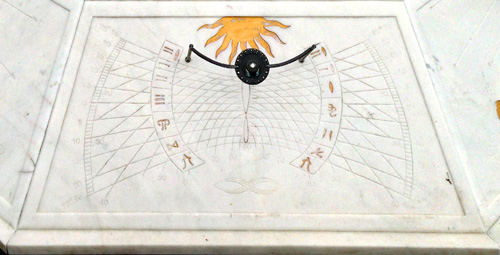
But not just a sundial. Each of the sides of the base plinth has a further astrological or astronomical theme, including one with the phases of the moon on it, and this one with the zodiac symbols and a sun dial which I just can’t work out. (Again, can anyone out there help me?)
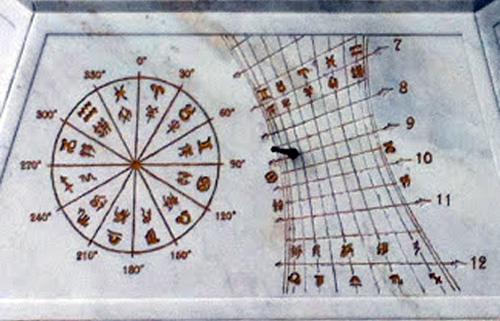
One of the things I love about this garden is the preponderance of Buddhist Pine trees. In China they are known as 羅漢松, or luohan song – literally ‘arhat pine’. They are small to medium sizes evergreens, not pines at all, reaching 20 metres high. It is a popular large shrub or small tree in gardens, particularly in Japan (and is actually the state tree of Chiba Prefecture there). Because of its resistance to termites and water, it is used for quality wooden houses in Okinawa, whilst in Hong Kong Buddhist Pine is highly regarded as a feng shui tree, giving it a very high market value. Apparently In recent years, the illegal digging of Buddhist Pine has become a problem in the city.
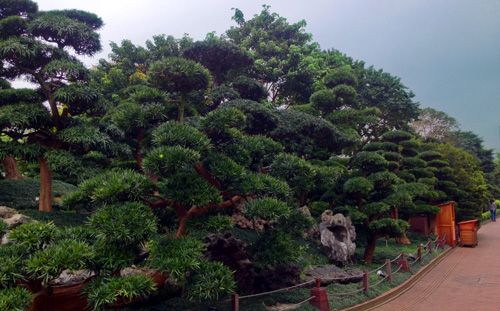
Another thing I like about this garden is that someone had a sense of humour in its design. Take a careful look at this skull and cross bones, for instance. I don’t think I have ever seen one like this before!
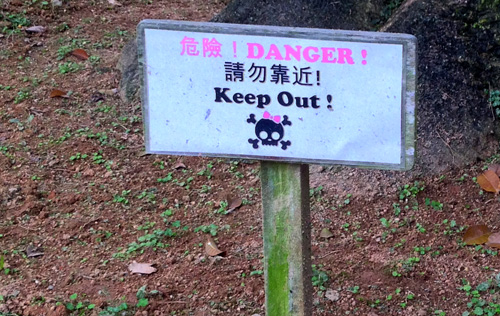
A little further on from the ‘The Lamp of Enlightenment’ is a smallish collection of bonsai trees; or perhaps it would be more accurate to give it the Chinese name of Penjing (盆景- literally ‘tray scenery’), rather than the Japanese term we use in the UK. Again, not the most stunning display I have ever seen – Beijing spoils one for that too – but pleasant all the same.
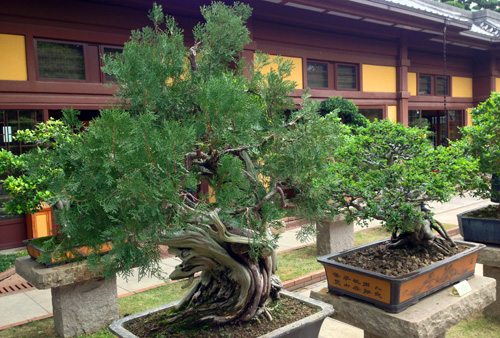
And just behind is another Gallery – this one with a rockery display of stones from the Hongshui River. But again, I have to say I’m not that turned on by these rocks, and make a hurried exit from the other end of the gallery.
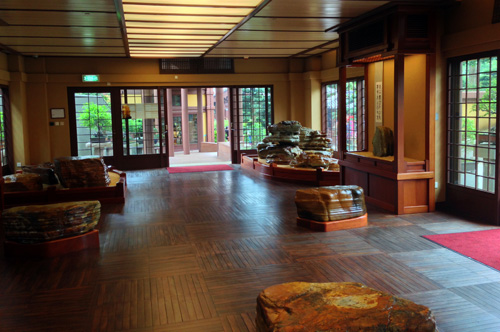
In the northeast corner of the garden is a restaurant which apparently has a good reputation for vegetarian food. It is managed by the Chi Lin Nunnery and serves a variety of so-called gourmet meals.
The restaurant is situated behind a waterfall called the Silver Strand, and has a panoramic window allowing diners to look through the cascading water into the gardens. Perhaps this is another of its attractions, quite apart from the quality of the food.
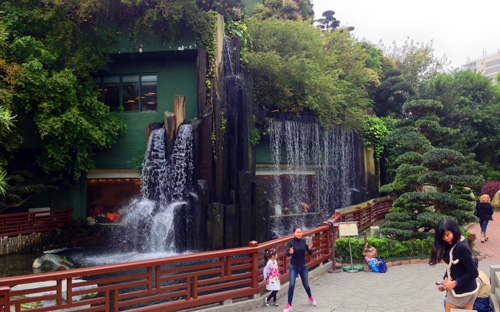
From the restaurant one can look to the west through the Pavilion Bridge towards the Blue Pond. There’s also a path leading to the Song Cha Xie – a Chinese teahouse, built on the northern side of the Blue Pond whose central courtyard is occasionally used for staging mini-concerts and dramas.

This so-called Blue Pond is stocked with Koi carp, and you get an excellent view looking down from the Lunar Reflection Terrace, not just at the Pavilion Bridge...
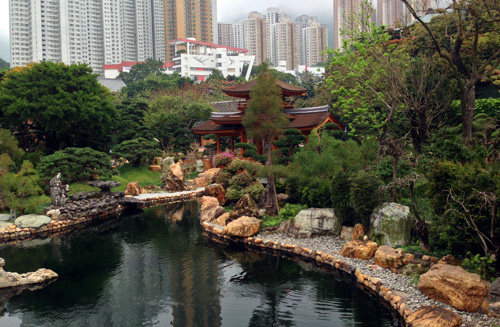
but also towards the Song Cha Xie.

Finally one arrives at the Perfection Pavilion connected by its two red painted timber Zi and Wu Bridges crossing the Lotus Pond. As I said before, this is for me a total let down. If only they hadn’t smothered it in gold paint it would have been quite nice. But it just seems totally out of keeping with the rest of the park. Ah well… What do I know?
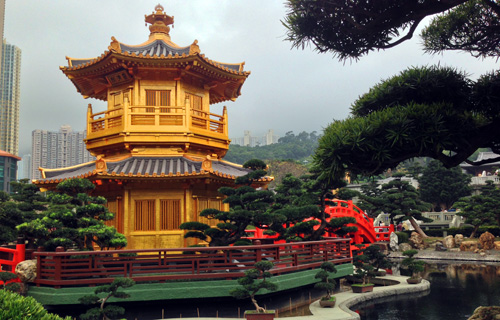
Once one has completed a circuit of the park, it’s time to cross the Fung Tak Road by means of a stone bridge which leads one towards the Chi Lin Nunnery. On the top of the bridge itself are some stone seats and some rather snazzy lighting. Unfortunately I didn’t get a chance to see them lit up.

Chi Lin Nunnery itself was built in 1934 and covers over 33,000 square metres. It consists of loads of different halls, lotus ponds and a five-floor thousand-buddha pagoda. It was substantially rebuilt using designers, architects and traditional craftsmen from China, Hong Kong and Japan, before being opened to the public in May 2000.
The nunnery is home to about 60 nuns who, since 2006 have managed the adjacent Nan Lian Garden (which it helped to design and fund). Like Nan Lian, the nunnery is also modelled on the architectural style of the Tang Dynasty. In constructing the buildings, no nails were used. Instead traditional techniques using bracketing and dowels were employed to hold the timber structures together. Only natural materials such as clay, stone and wood were used. The main halls, which are built on a north-south axis, face the sea and back on to the mountains with ancillary halls to the east and west.
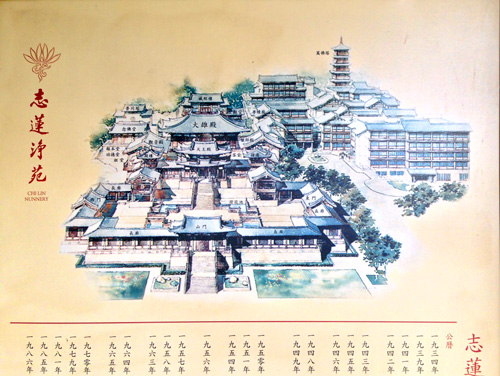
The complex is arranged around three courtyards of which only two are open to the public. Visitors enter through the Shanmen ('mountain gate') to the first courtyard, which contains landscaped Lotus Gardens with four large lotus ponds, statues, rockeries, bonsai trees in pots, cypress and peony trees.

At the opposite end of the courtyard one looks towards the Hall of Celestial Kings; but before doing that, a slight side tour to the western gate (what are those breasts for, I ask myself!) …
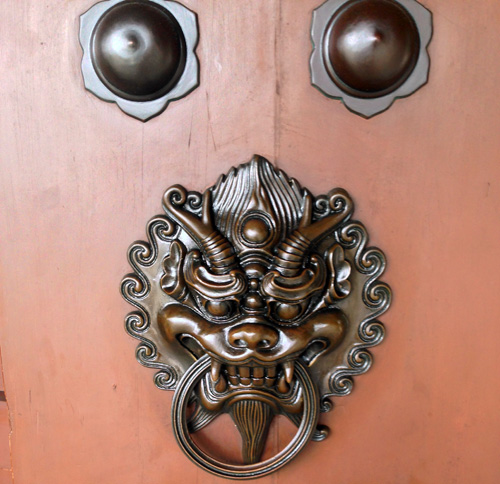
…gives a view onto a small garden with loads of bougainvillea, bottle-brush and other red and purple flowers. It’s all really rather nice!
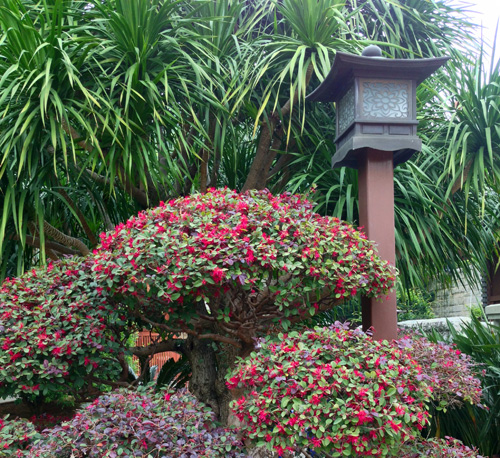
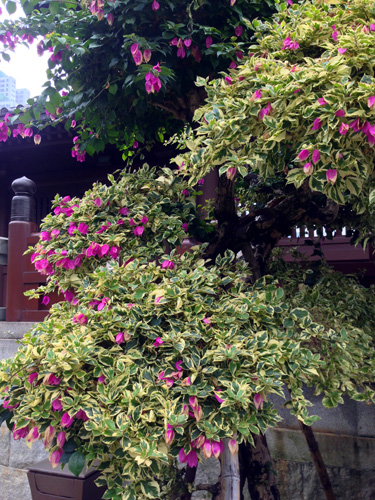
But back to the Lotus Ponds… and corridors with colonnades run along either side of this courtyard
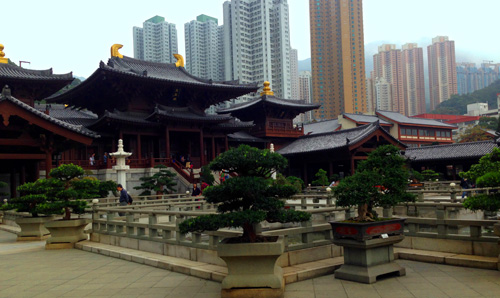
Within the corridors are loads of polished rocks standing on plinths. They obviously enjoy their bits of stone here.
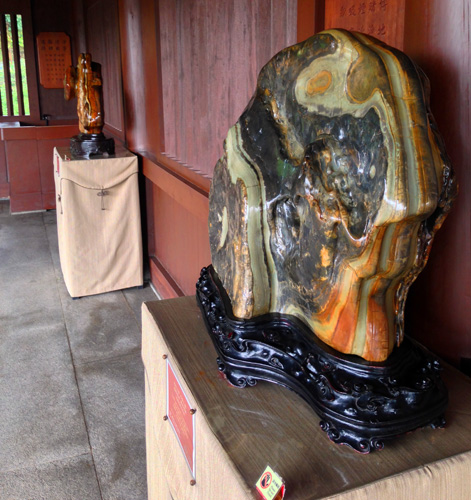
To make it even more meaningful, each plinth has a quotable quote from some well known man of letters. Hardly what you might call earth shattering, perhaps, but you can’t help but read each one to see if they get any better.
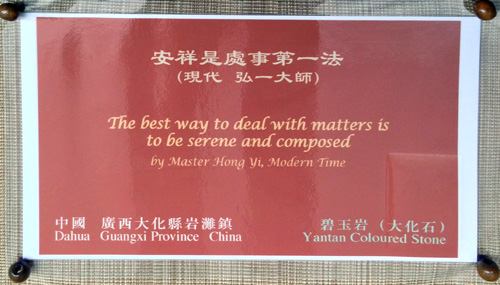
Or this next one...Not sure I agree with this . Surely one needs foolish men to make oneself feel less inadequate? Oops… what a giveaway! LOL
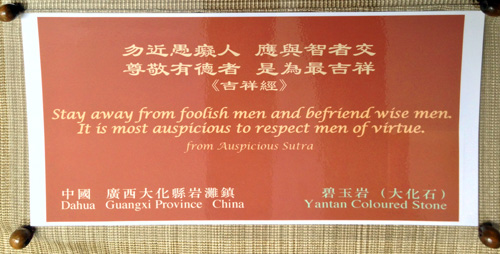
Like the Nan Lian Garden, one has to keep reminding oneself that there is a bustling city just outside the perimeter of this nunnery. Looking back, you see all the high-rises; but inside, the place is serene and peaceful.
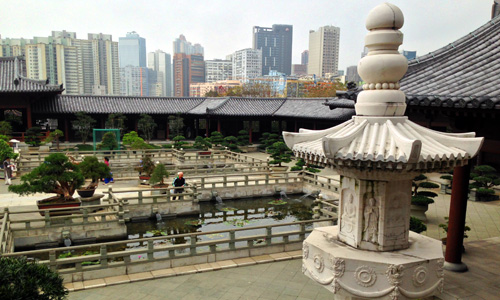
Inside the main door of the Hall of Celestial Kings is the statue of the Maitreya Buddha seated on its altar and surrounded by images of the Celestial Kings. One cannot take photographs here, in common with most temple complexes. The north door of the hall leads to the second courtyard, which is also most pleasant.
This inner courtyard is surrounded by five halls and has covered passageways on either side. On the right hand side of the courtyard are the the Ksitigarbha Hall with its statue of the Bodhisattva Ksitigarbha; while the Hall of Bhaisajyaguru contains the statue of the ‘medicine Buddha’ holding a medicine bowl and flanked by the Suryaprabha and Candraprabha (sunlight and moonlight) bodhisattvas.
The Main Hall on the opposite side of the courtyard to the Hall of Celestial Kings is a magnificent structure with a roof of 28,000 clay tiles, weighing 176 tons, supported by twenty-eight cedar columns.
Inside the hall are five gilded Buddhas. In the centre is the seated Buddha Sakyamuni, the founder of Buddhism in India and known as ‘the Enlightened One’. He is flanked by two standing bodhisattvas, Mahakasgapa and Ananda and two seated bodhisattvas, Marjusri and Samantabhadra.
Beyond the Main Hall, the third courtyard houses the Ancestral Prayer Hall, Dharma Hall, Patriarch Hall and the Ten Thousand Buddhas Pagoda containing over 10,000 Buddha images – but unfortunately these are not open to the public.

So it’s time to turn round and head off for the entrance once again. One of the quotable quotes rears its head as I pass by.
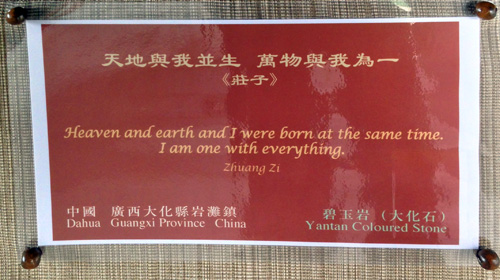
I think I, too, am at one with that.
Take MTR to Diamond Hill, exit C2. Cross the road at the traffic lights
